New Rules for New Masonry-Construction Cleaning
For New-Construction Clean-Down of Contemporary Masonry Buildings
Cleaning today’s relatively new concrete masonries, like simulated stone and concrete brick, is different from cleaning clay masonry. Clay masonry can usually withstand the more aggressive cleaners needed to dissolve hardened mortar smears. But even clay masonries now vary enough in type to take particular procedures and products.
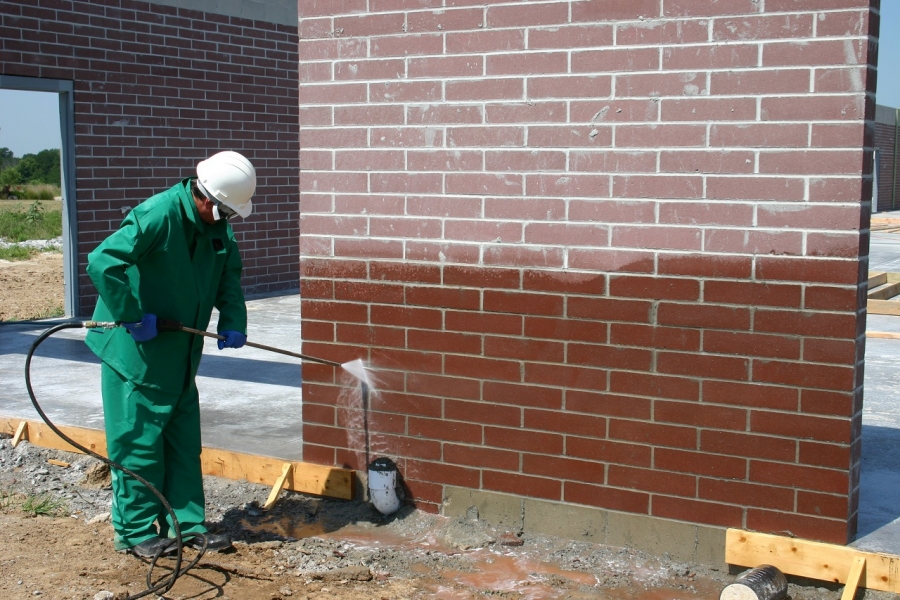 Courtesy of Chris Millspaugh, PROSOCO
Courtesy of Chris Millspaugh, PROSOCO
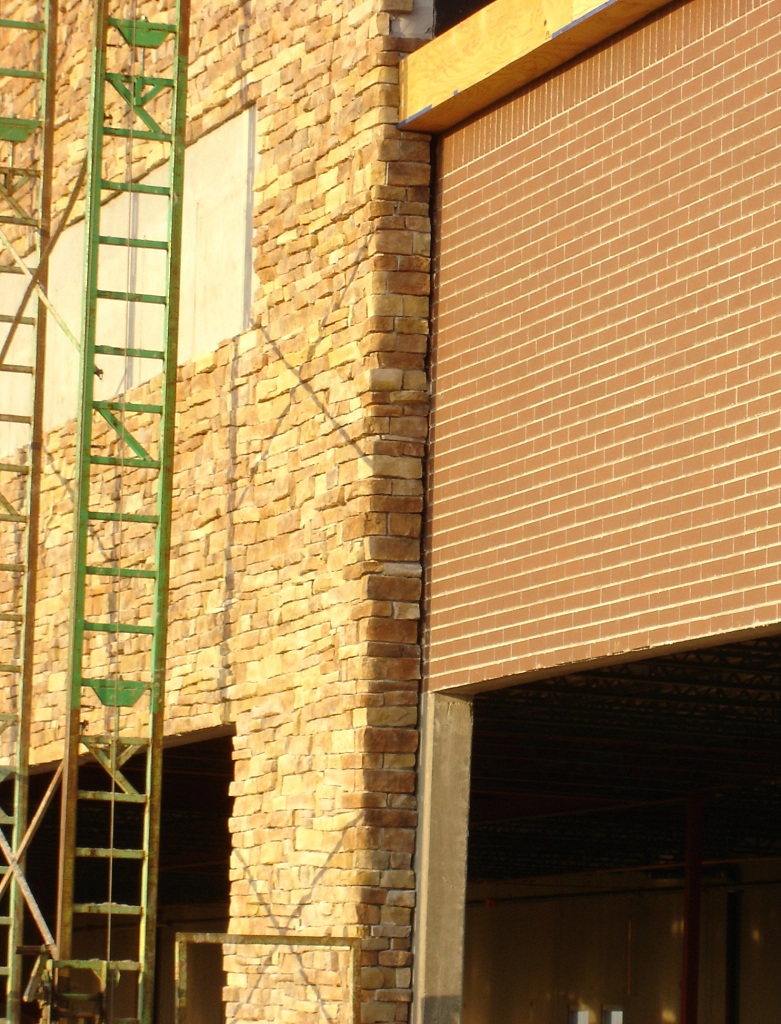 Manufactured stone and clay brick co-exist in this under-construction shopping mall in Olathe,Kan. Different masonry types in the same wall or structure can pose a challenge for post-construction clean-down.
Manufactured stone and clay brick co-exist in this under-construction shopping mall in Olathe,Kan. Different masonry types in the same wall or structure can pose a challenge for post-construction clean-down. The situation gets even more complicated when you consider that many of today’s buildings increasingly are mixtures of different types of masonries.
A typical example is the Municipal Building, Edgewood, Ky., completed in 2006.
That one structure has red and gray clay brick, cream-colored architectural block, cast stone and precast concrete. You’ve seen buildings like that. You’ve likely worked on some.
Long gone are the days when masonry meant red clay brick and gray mortar only. Long gone are the days of “one size fits all” post-construction cleaning of new masonry. Cleaning that way now can mean disaster.
The good news is that by following a few simple guidelines, you can bring home great results every time on even the most complicated combinations of concrete, clay and stone masonry, natural and simulated.
Some of those guidelines, like “Always test before overall cleaning,” are timeless. Others, like “clean early and quickly,” have been around, but are increasingly important.
Still others, such as “Know your surface” are new rules for masons brought up in the traditions of “masonry equals brick or block,” and “one size fits all” for cleaning them.
The new rules
1. Know your surface.
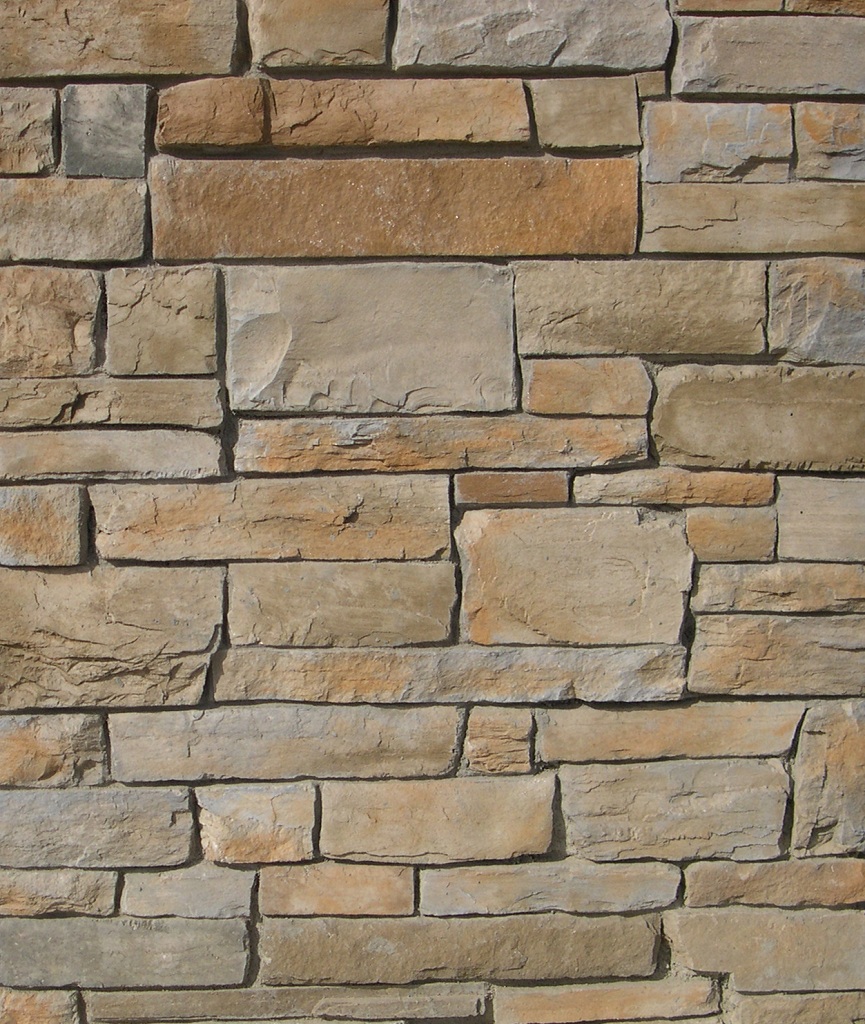 Natural or simulated? It's the job of the manufactured stone to look like natural stone. If you're cleaning it, however, you'd better know the difference.
Natural or simulated? It's the job of the manufactured stone to look like natural stone. If you're cleaning it, however, you'd better know the difference.A knowledgeable and professional contractor cleaned a two-story brick office building in Indiana in 2003. He used a proprietary product from a reputable manufacturer, and followed responsible procedures just like he always did.
Too late, the contractor discovered he was cleaning concrete brick, not clay brick. The powerful cleaner, though safe for clay brick, pitted and bleached the concrete. The contractor landed in court.
Concrete brick and simulated stone often look like clay brick and natural stone – that’s the idea. But between concrete and clay, and simulated and natural, are widely different tolerances for cleaner-strength and pressure-washer psi.
Also, cleaners for concrete products often contain non-etching ingredients not used in their counterparts for clay masonries. The small amounts of acid(s) found in cleaners for clay and concrete are usually different as well – specialized for particular substrates.
Even individual types of clay brick or natural stone have important differences. Some clay bricks have special additives that create striking color effects. An inappropriate cleaner can react with those additives, causing hard-to-remove stains.
Cleaning limestone or cast stone the same way you clean granite or sandstone can etch or bleach. As soon as you get the job, get on site and positively identify every substrate you’ll be cleaning.
Know your surface!
2. Always test before overall cleaning.
When SparkleWash International contractor Craig Christensen, Omaha, Neb., cleaned the simulated river stone exterior of Cabela’s, Omaha, he followed rule number one. Christensen got on the job site as soon as he could to examine the rounded, multi-colored concrete stones.
He got samples from the mason contractor and took them back to his shop. The stones came in eight colors. Christensen tested cleaners on each one. He found that six of the stones were integrally colored, and could stand up to a vigorous cleaning with the right product.
The other two sported a cementitious surface coating to give them their color. The cleaning technique that worked on the integrally colored stones easily bleached out these two.
After his shop tests, Christensen field-tested his cleaning procedures on an out-of -the-way spot of the Cabela’s wall, in the same conditions in which he planned to clean.
The knowledge gained from testing guided Christensen to a successful job. It was a project that could’ve easily tripped up someone with a more casual approach.
Always test, and always clean under the same conditions you tested under.
3. Use the mildest cleaner and dilution that still gives effective results.
Cleaners for concrete masonry are gentler than their counterparts for clay. That’s because concrete masonry has some of the same components as the mortar films and smears that have to be removed before buildings are ready for clients.
The best concrete and manufactured stone cleaners are precisely balanced – just strong enough to dissolve films and mortar smears that aren’t fully hardened. They’re safe enough to do that without harming the masonry.
On a building that combines clay and concrete masonry, the cleaner made for clay might harm the concrete, unless you take precautions. But if you get to the job early enough – before the excess mortar has fully hardened – the same gentle cleaner and dilution that’s safe for concrete will also effectively clean the clay brick.
That brings up rule 4 – clean early and quickly.
4. Clean early and quickly.
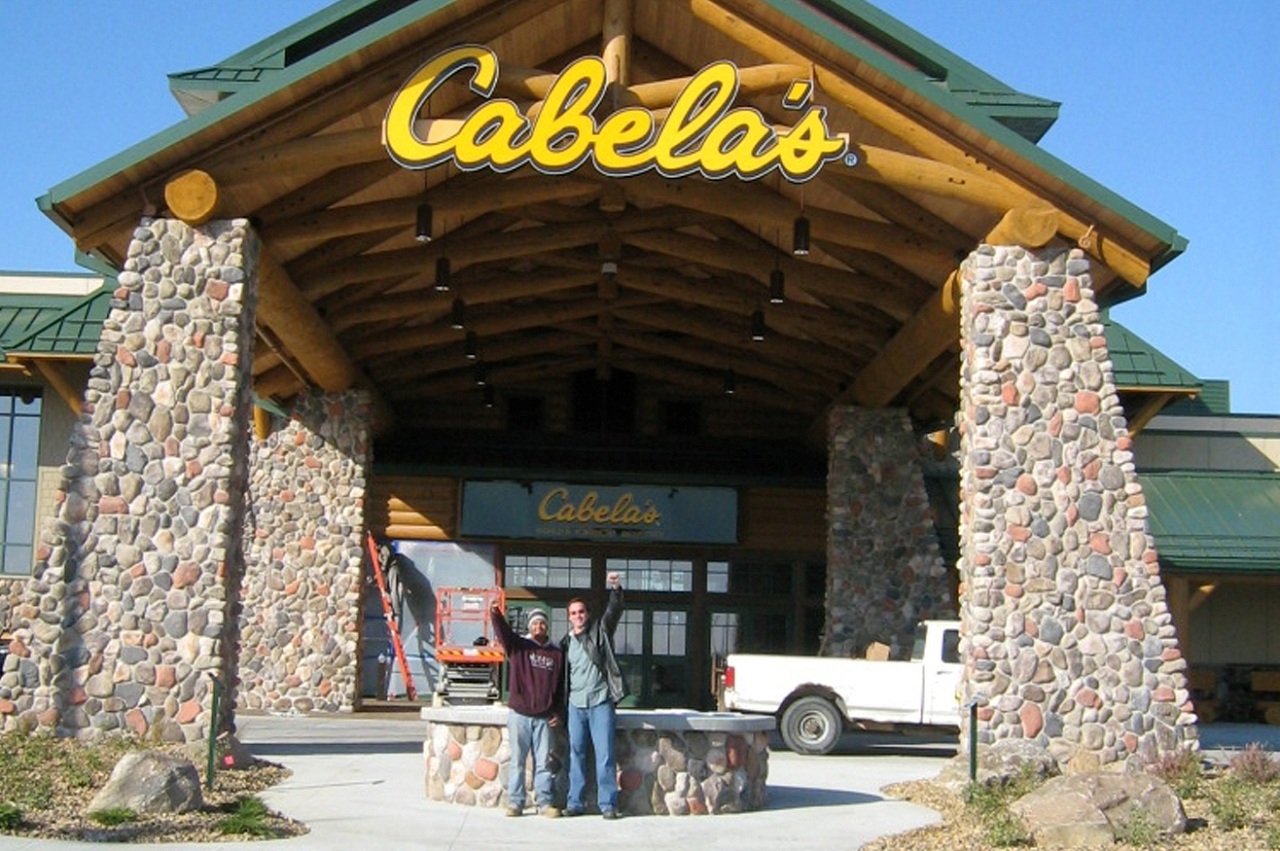 Not all manufactured stones are created equal. Six of the eight types of stone of this building are integrally colored and could stand up to a vigorous cleaning. Two of the eight get their color from an applied surface coating that would've been bleached out from a vigorous cleaning. The cleaning contractor discovered the difference in testing, and cleaned the building successfully.
Not all manufactured stones are created equal. Six of the eight types of stone of this building are integrally colored and could stand up to a vigorous cleaning. Two of the eight get their color from an applied surface coating that would've been bleached out from a vigorous cleaning. The cleaning contractor discovered the difference in testing, and cleaned the building successfully.A masonry contractor in Indianapolis didn’t have enough water on site to clean his new concrete brick car dealership. He waited 60 days until a waterline and hydrant were installed.
By then, the smears and films of the high-strength mortar had become too hard for the relatively gentle cleaner – though it was a good one – to dissolve. The clean-down was ineffective. The general contractor’s idea was to tear it down and start again, at a price tag of $100,000 – which he thought the masonry contractor should cover.
Don’t give mortar smears and films a chance to become as hard as the masonry. Get it off while it’s still relatively soft. You should be OK if you clean most concrete masonry within 7-21 days of installation. High-strength mortars and grouts are another matter. Clean those within 3 - 7 days.
Since cleaners for clay brick are more aggressive than those for concrete and simulated stone, the cleaning window is a little different. Fourteen to 28 days is about right. The general principle is the same though – the younger the excess mortar, the more easily it comes off, whether you’re cleaning clay or concrete.
Don’t clean too early, though -- you could damage the joints.
5. Use the right cleaner for the right job.
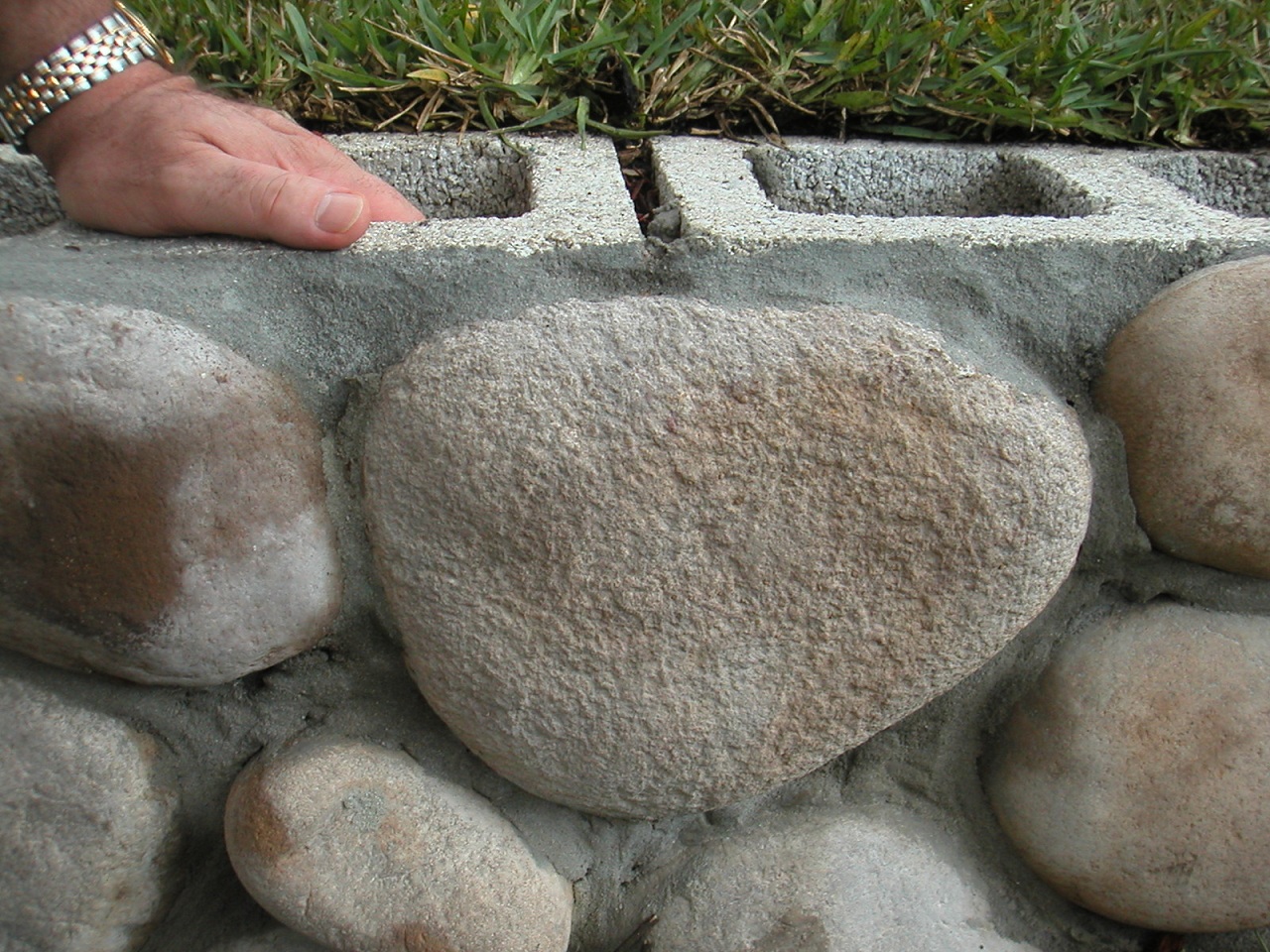 The cleaner was appropriate for clay brick. Unfortunately, the contractor didn't test it before use on this simulated stone. The cleaner removed most of the stone's surface-applied color, along with the excess mortar and job dirt.
The cleaner was appropriate for clay brick. Unfortunately, the contractor didn't test it before use on this simulated stone. The cleaner removed most of the stone's surface-applied color, along with the excess mortar and job dirt.How do you know what the right cleaner is for any given masonry? Chances are the masonry manufacturer will be glad to tell you. It’s an increasingly common practice for manufacturers to have their products tested by an independent lab to see which cleaners work best, and at what dilutions.
That crucial info is often supplied automatically in the form of a pallet tag on every cube of masonry. If not, manufacturers will usually be glad to give you their recommendations on request for cleaning their products.
It’s in their interests as well as yours to have projects come out looking as beautiful as you can make them.
On a project with multiple masonry types, you may be able to clean the entire building with one cleaner -- IF – you get to it early enough to use the mildest cleaner and dilution possible. See rules three and four.
Otherwise, follow the masonry manufacturer’s guidelines for cleaning each type of masonry.
6. Never clean with raw acid.
Once upon a time, raw acid was all there was to clean with. Since those days, advances in the manufacture of masonry and other construction materials have made use of raw acids, such as muriatic, very dangerous. Muriatic acid in particular is impure in content, and inconsistent in strength. It can and has stained and etched nearly every type of masonry, landing many a contractor in a legal bed of thorns.
Don’t use it!
7. The basics still apply – follow them.
Don’t spare the water.
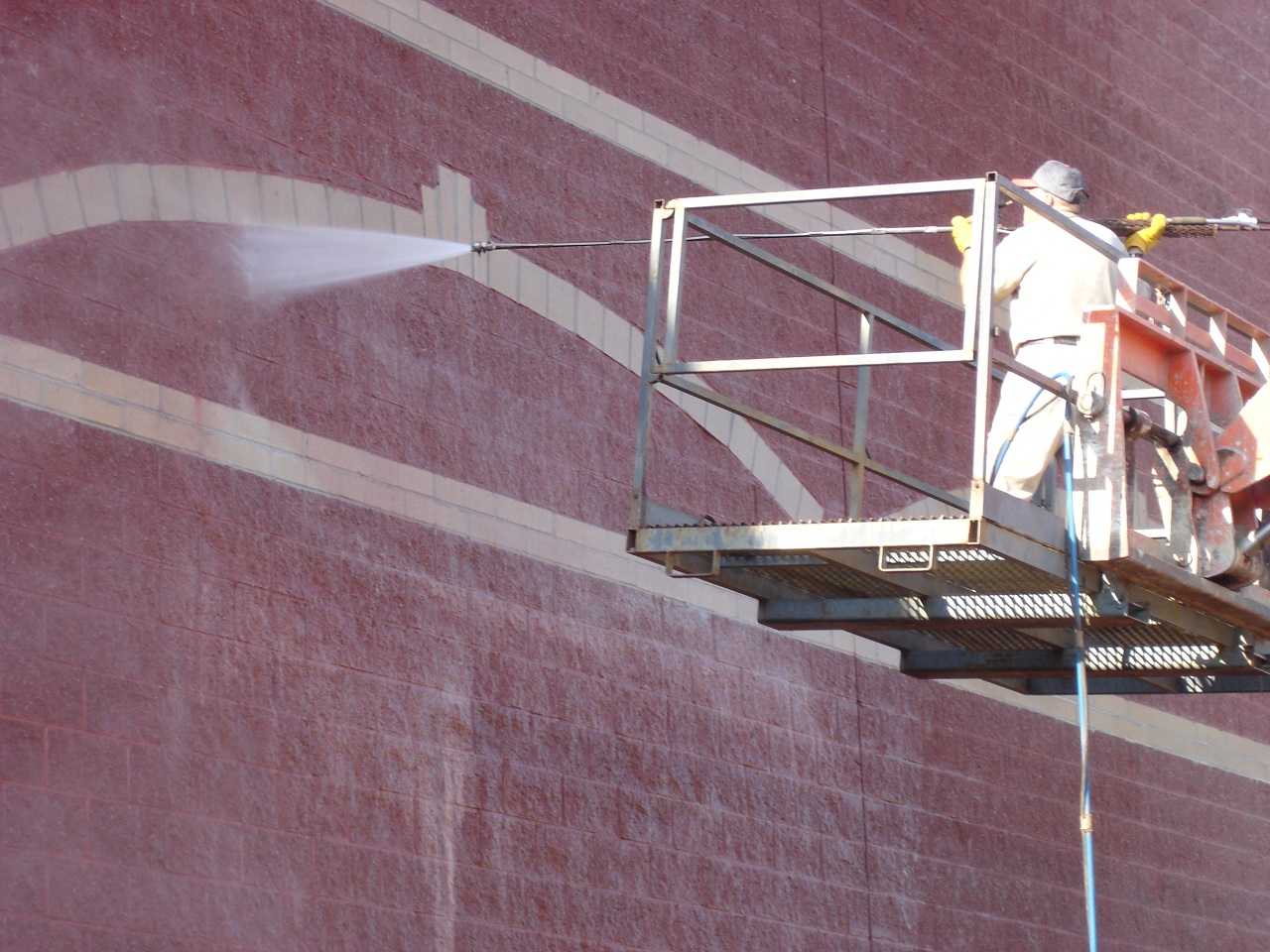 We're not talking garden hose here. Plenty of water, in both the pre-washing and rinsing steps, is vital to a successful post-construction clean-down of new masonry.
We're not talking garden hose here. Plenty of water, in both the pre-washing and rinsing steps, is vital to a successful post-construction clean-down of new masonry. Lots of water is one of the secrets to a great masonry clean-down. Before applying the cleaner, drench the masonry (it’s called pre-wetting). When the masonry pores are filled with water, the cleaner can’t soak in. It stays on the surface, where it does its job of dissolving excess mortar and job dirt.
Use more water to rinse the spent cleaner and dissolved mortar and job dirt off the wall. We’re not talking garden hose here. Weak rinsing can leave stains and residue.
Ideally, rinse with 400 to 1,000 psi, at 6-8 gallons per minute.
Clean bottom-to-top, and always keep lower areas wet to prevent streaking.
A contractor in New Orleans began cleaning at the top of a building that featured red clay brick and red mortar above white cast stone. He paid no attention to keeping the areas beneath the cleaning wet.
The result was that reddish rundown from the cleaning soaked into the white cast stone, leaving nasty streaks. Fortunately, a remedial cleaner corrected the situation. Unfortunately, the cleaning contractor was required to do the remedial cleaning at his own expense. That amounted to thousands of dollars and several weeks of lost time.
Unlike many other types of cleaning, masonry clean-down begins at the bottom and works up. That makes it easier to keep lower parts of walls wet. Keeping them wet stops rundown from penetrating.
That’s important, if you plan to make money on your jobs.
Follow all safety precautions in the product literature
Many of these guidelines are common sense, like “don’t get this product in your eyes,” or “wear protective clothing.” Guidelines such as “don’t cut or alter these cleaners with other chemicals, or with bleaches" keep people and masonry safe.
Use the cleaner only as specified. Results may be unpredictable if you use the cleaner for anything else. By closely following all safety guidelines – written by field service experts – you maximize your chances for a successful, accident-free cleaning job.
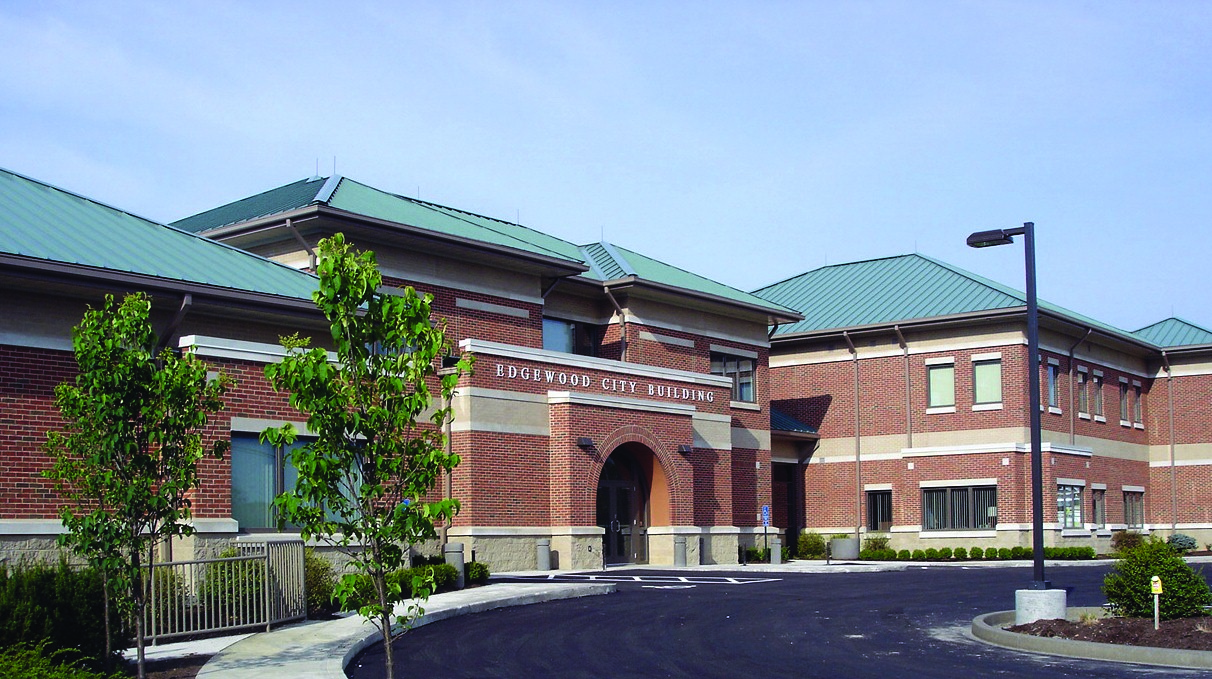 A typical example of today's masonry, the Municipal Building, Edgewood, Ky., features brick, architectural block, precast concrete, and manufactured stone. The rules for cleaning such buildings vary from those for cleaning buildings of mostly one type of masonry.
A typical example of today's masonry, the Municipal Building, Edgewood, Ky., features brick, architectural block, precast concrete, and manufactured stone. The rules for cleaning such buildings vary from those for cleaning buildings of mostly one type of masonry.In cold weather, remember the rule of 40 and Rising rule
Though you get the best results when air and surface temperatures are well above freezing, construction schedules often dictate that cleaning takes place when conditions are less than ideal. If you have to clean during cold weather, follow these tips.
- Water-saturated masonry is vulnerable to freeze/thaw damage. Never clean if the masonry could freeze before drying.
- Chemical cleaners and rinse water rely on chemical reactions to dissolve and rinse away construction soiling. Cold temperatures slow these chemical reactions. Compensating for the cold by using a stronger cleaning solution may cause permanent damage to the masonry -- especially today’s sensitive colored concrete and manufactured stone.
- Instead, extend the dwell time of the properly diluted cleaning solution by 10 – 20 percent. Scrub areas of heavy soiling with a masonry washing brush. Pre-wetting and rinsing with hot water also warms the surface and improves results.
- Schedule wet cleaning for when air and surface temperatures are 40°F and rising. That’s the “40 and rising” rule. In cold weather, this means your wet cleaning window may only be a few hours around noon. Use the time before and after to remove heavy accumulations of excess mortar and job dirt from the next day’s work area with dry brushing and scraping.
- If a limited cleaning window is impractical, enclose the work area with polyethylene and use space heaters to warm the masonry. This extends your workday and improves results.
- One final caution – warm weather test panels won’t work for cold weather cleaning. Test in cold to clean in cold.
Don’t go it alone.
Never try to guess your way through problems or questions. The masonry manufacturer, distributor, sales rep or masonry cleaner manufacturer are always happy to do all they can to help. The right answer is usually just a phone call away.

Gary Henry
Gary is a journalist and technical writer for PROSOCO, a manufacturer of products for cleaning, protecting, and maintaining concrete, brick, and stone architecture. A writer throughout his professional life, Henry has focused on construction-related issues since joining PROSOCO in 1999.
Website: www.prosoco.com
